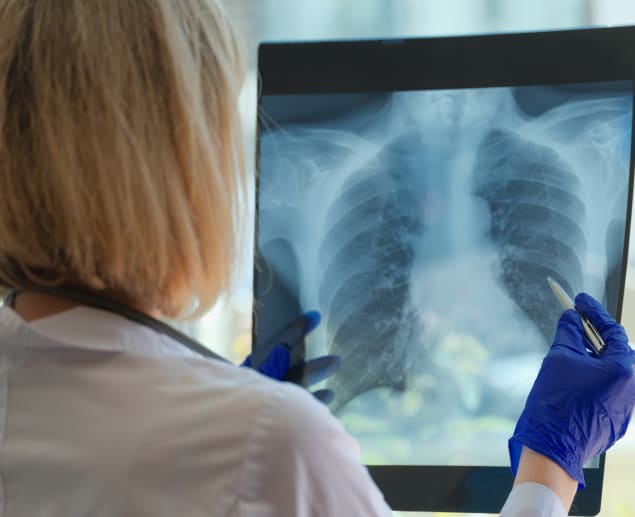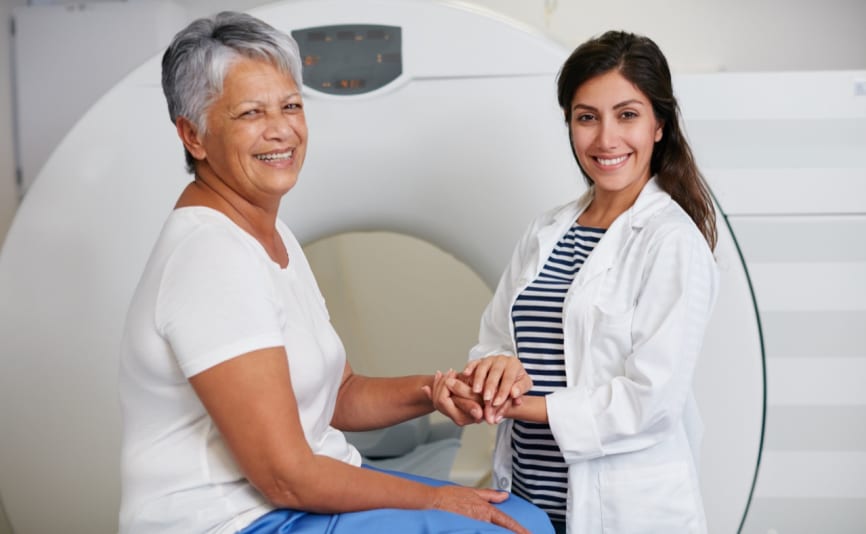If you are planning to travel to a destination that requires a chest X-ray for tuberculosis (TB) as part of your visa application, or if you are concerned about TB due to recent travels, this comprehensive guide will help you understand everything you need to know.
We cover the meaning of tuberculosis, how to get diagnosed using a chest X-ray, why it is so important to get tested, how to see tuberculosis in X-ray images, how to book a TB test for a UK visa, where to book one in the UK, and the costs involved.
What is tuberculosis (TB)?
Tuberculosis, or TB, is a serious infectious disease caused by the bacteria Mycobacterium tuberculosis.
It spreads through the air when an infected person coughs, sneezes, spits, or speaks, releasing microscopic droplets that can be inhaled by people nearby.
TB primarily affects the lungs (known as a pulmonary TB infection), but it can affect other organs (e.g., bones, heart, and brain).
Our immune system is built to fight and contain the bacteria when it first enters the body, causing it to go into a dormant phase (also called a latent or sleeping stage) where it can’t multiply inside the body, cause painful symptoms, or spread to others. But, if a person’s immune system gets compromised by ageing, lifestyle stresses, or illness, a latent TB infection can easily be activated.
In the active stage, tuberculosis begins to reproduce rapidly, causing tissue damage and symptoms like persistent cough, coughing up blood, chest pain, weight loss, night sweats, and fever.
How is TB diagnosed using a TB Chest X-ray?
A TB chest X-ray is an invaluable tool for diagnosing tuberculosis. It is a quick, non-invasive, and relatively inexpensive method to visualise the lungs and detect any abnormalities that may suggest TB infection.
During a chest X-ray for TB, you will be asked to stand in front of an X-ray machine and hold your breath for a few seconds while the image is taken.
The machine sends a beam of low-dose radiation through your chest to an X-ray detector on the opposite side, creating an image of your lungs, ribs, heart, and surrounding structures.
An X-ray detector creates images of different tissues based on the amount of radiation they absorb or allow to pass through them. For example, your dense ribs absorb more radiation and appear bright or white on X-ray images, while your lungs, which are less dense, appear darker.
When TB is actively growing in the lungs, it can cause nodules or masses and potentially damage some tissues, especially near the top or middle of the lungs. These areas absorb more X-rays than the surrounding lung tissue and usually appear as noticeable white spots on tuberculosis chest X-ray images.
It’s important to note that while a chest X-ray is effective for showing changes in the lungs, it can’t detect a latent TB infection or may sometimes miss an early active TB.
Therefore, other tests may be combined with a TB chest X-ray, especially if the X-ray shows abnormal findings or is inconclusive, to get a definitive diagnosis.
These tests include the tuberculin skin test (TST), TB blood test (interferon-gamma release assays or IGRAs), and sputum test (or sputum culture).
Tuberculosis (TB ) Chest X-ray findings
What does TB look like on a chest Xray?
If you are wondering what TB on chest x-rays looks like, here are some defining features to look out for and how they appear on x-ray images:
-
Infiltrates or consolidation: These occur when the small airways in the lungs are replaced by a substance (e.g., pus, blood, fat, water, or cells) much denser than air and appear as cloudy or opaque areas.
-
Cavitation: Cavities are round, hollow spaces that can appear dark on the x-ray.
-
Pleural effusion: An accumulation of fluid between the pleura (two thin layers of protective tissue) that protects and cushions the lungs. It typically appears as a light grey or white area.
-
Ghon complex: The presence of a lesion, scarred tissue, cavitation of the lesion, and consolidation in the affected lobe all in one. It appears as a small, round, white spot on a chest x-ray.
-
Lymphadenopathy: Enlarged lymph nodes in the chest can appear as lumps on the x-ray.
-
Miliary pattern: Small, 2-3 mm nodules, usually scattered around the lower lobe of the lungs, are the hallmark of TB spread throughout the lung. On X-ray images, they appear like small, white spots and might resemble millet seeds, hence the name miliary.
Sometimes, a TB chest x-ray might return an inconclusive result. If this happens, it doesn’t necessarily mean that you have TB; it only means that additional tests are required to get a more comprehensive evaluation.
Since an inconclusive TB chest X-ray result can’t be used in your visa application, the next preferred testing option for your visa X-ray is the sputum test. In this test, a sample of your phlegm (a thick mix of saliva and mucus produced by the body in response to infections or respiratory conditions) coughed up from your lungs will be taken and tested for the presence of Mycobacterium tuberculosis.
TB Chest X-ray positive vs Normal
A positive TB chest x-ray will show the abnormalities described above, whereas a normal chest x-ray will show clear lung fields (which appear as uniform black-coloured areas) without any signs of infection or disease.
However, it’s important to note that not all lung abnormalities seen on X-ray images are caused by TB.
Other conditions, such as pneumonia or lung cancer, can sometimes produce similar x-ray findings. If there are no distinctive features present to confirm a TB diagnosis, further testing is often required.
Why do I need a tuberculosis x-ray for a visa?
Tuberculosis is the second-deadliest infectious disease after COVID-19, causing an estimated 10.6 million people to fall ill and 1.3 million to die in 2022. It is also said to cause the deaths of 3,500 people daily.
Many countries require a tuberculosis chest X-ray as part of their visa application process as part of measures to prevent the spread of the disease and protect public health. It helps raise awareness so that people with active TB can get diagnosed and receive appropriate treatment before travelling for leisure or emigrating.
Each country may have specific requirements for the TB test. Some require it if you are visiting for close to or longer than 6 months or have stayed in a country that doesn’t have a low incidence of TB in the last 6 months, while others may request it if you’ve been away for more than 2 years.
Also, not everyone is required to have a chest X-ray; in some cases, children under age 11 and pregnant women may be provided alternative options to verify their health status.
Since TB test requirements vary by country, it is important to check with the destination country's embassy to be well-informed about what you need for a successful visa application.
How long is a chest x-ray for tuberculosis good for?
Usually, a chest X-ray result confirming that a person is free from active, infectious tuberculosis is used to create a TB clearance certificate. The validity of this certificate can vary by country, but it typically expires 6 months from the date of the X-ray. If the person has been in contact with a family member who has active pulmonary TB, the certificate may be valid for only 3 months.
You should always verify the validity of your TB chest x-ray results with the embassy of the country you wish to visit to avoid any issues with your visa application.
UK TB test online appointment booking
If you would like to know how to book a TB test for UK visa applications, the government website can provide all the help you need regarding visa medicals, including TB testing requirements or exemptions and approved clinics for tuberculosis screening.
Your visa application will not be considered if you don’t obtain a TB test certificate from a Home Office-approved clinic, so it is crucial to check the website for the approved centre(s) in your city and book well in advance to avoid any delays.
For UK citizens needing TB chest x-ray results for their visa applications, it’s easy to book a UK TB test online appointment via Scan.com.
Tuberculosis X-ray locations
If you are looking to book a TB chest X-ray for visa applications, Scan.com offers many locations you can choose from, including major cities like London, Birmingham, Manchester, Glasgow, Edinburgh, and others.
With unrestricted access to our growing network of over 150+ scanning centres nationwide, finding the most convenient one is a breeze! Simply select the body part you want scanned (i.e., chest), enter your postcode or town, and click the ‘Search’ button.
Now you can book your visa X-ray at a scanning centre that best fits your location, schedule, and budget. Plus, you'll receive your results quickly, keeping you on track for your visa application.
Tuberculosis chest x-ray costs
Starting from £100 to £220, you can book a tuberculosis chest X-ray with Scan.com.
The cost of your booking covers your scan at your selected partner scanning centre, as well as a scan referral, pre- and post-scan consultations with our expert clinician team, digital access to a patient-friendly radiologist report, and copies of your TB chest x-ray images available upon request.
Not sure if you need a chest X-ray to check for tuberculosis? Book a consultation for £50 to speak with one of our expert clinicians. They will review your medical history, provide tailored education on the benefits and risks of the available scan options, and offer a no-obligation referral to the one that’s most suitable for your specific needs.
Sources:
-
Cattamanchi, A. (2023, December 12). Tuberculosis X-ray Findings and What They Mean. Healthline. Retrieved August 6, 2024, from https://www.healthline.com/health/tuberculosis-x-ray
-
Ending the Global Tuberculosis Epidemic | Global HIV and TB. (2024, June 13). CDC. Retrieved August 6, 2024, from https://www.cdc.gov/global-hiv-tb/php/our-approach/combatingglobaltb.html
-
Ghon Complex - StatPearls. (2023, April 23). NCBI. Retrieved August 6, 2024, from https://www.ncbi.nlm.nih.gov/books/NBK551706/
-
Latent TB testing in the UK, accessible text version. (2020, February 21). GOV.UK. Retrieved August 6, 2024, from https://www.gov.uk/government/publications/latent-tuberculosis-testing-in-the-uk/latent-tb-testing-in-the-uk-accessible-text-version
-
Parkar, A. P. (2016, November 19). Differential Diagnosis of Cavitary Lung Lesions - PMC. NCBI. Retrieved August 6, 2024, from https://www.ncbi.nlm.nih.gov/pmc/articles/PMC6100641/
-
Tuberculosis. (2023, November 7). World Health Organization (WHO). Retrieved August 6, 2024, from https://www.who.int/news-room/fact-sheets/detail/tuberculosis
-
Tuberculosis: Causes, Symptoms, Diagnosis & Treatment. (n.d.). Cleveland Clinic. Retrieved August 6, 2024, from https://my.clevelandclinic.org/health/diseases/11301-tuberculosis
-
Tuberculosis radiology. (n.d.). Wikipedia. Retrieved August 6, 2024, from https://en.wikipedia.org/wiki/Tuberculosis_radiology
-
Villalobos, N. (2023, December 20). Chest X-ray for tuberculosis (TB): What to expect, results, and more. MedicalNewsToday. Retrieved August 6, 2024, from https://www.medicalnewstoday.com/articles/tuberculosis-x-ray






